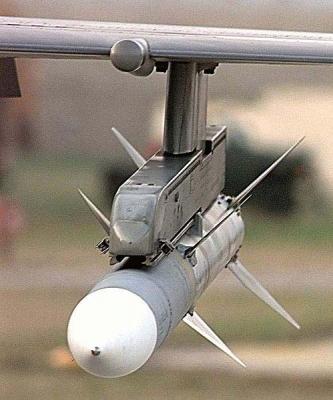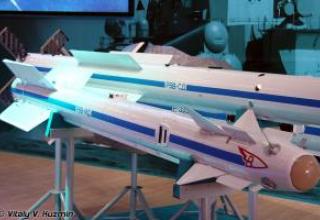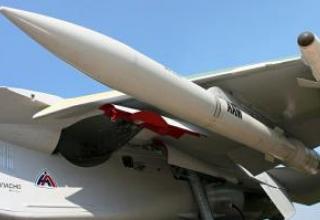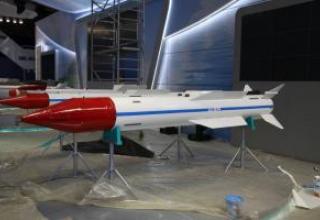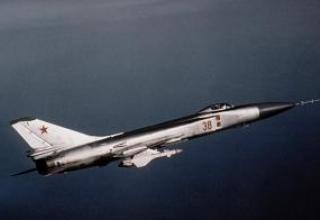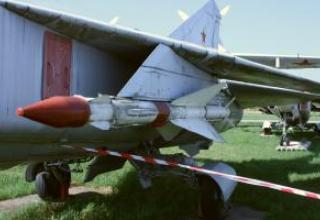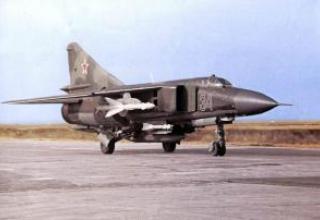The Air-to-Air Missile (AIM-120) is an air-to-air guided all-weather missile originally designated AMRAAM (Advanced Medium-Range Air-to-Air Missile) developed by Hughes Aircraft Co. The missile was adopted for service with the U.S. Air Force in 1991. In April 1998, the company "Raytheon Company System" received an order for the production of 813 AIM-120 missiles worth $ 243 million.
AMRAAM missiles of AIM-120A, A1M-120B, AIM-120B+, AIM-120C and AIM-120C-5 modifications are now the main air-to-air weapons of the US, NATO and other fighters (about 18 in total). The rearmament of the fighter fleets of these countries (F-4F, F-14D, F-15, F-16, F/A-18, Tornado, Harrier, JAS-39 Grippen, JA-37 Viggen) with the above mentioned missiles is made instead of AIM-7F, A1M-7M Sparrow. The new missiles were placed on the same LAU-17A and LAU-92 launchers. AMRAAM missiles were combined with F-22, Eurofighter Typhoon and Harrier-II aircraft.
Compared to the Sparrow AIM-120, the launch weight and dimensions of the missile have been significantly reduced, and the effectiveness of the fight against both high-altitude, energetically manoeuvring and low-altitude targets has been improved under conditions of intensive electronic warfare. This was made possible thanks to modern achievements in aircraft control theory, radio electronics and computer technology, propulsion systems and combat equipment.
A small number of F-18 fighters armed with AIM-120 missiles were relocated to the Persian Gulf area in 1991 as part of Operation Desert Storm, but they were not used in combat operations. The first combat application took place in December 1992, when an American F-16 fighter aircraft shot down MiG-25 of the Iraqi Air Force over the territory of southern Iraq.
Composition:
The AIM-120 missile follows the normal aerodynamic scheme and consists of three compartments: the main compartment, the combat unit (BC) and the tail compartment (see the scheme). It has a cross-shaped wing of a small area, which provides enough maneuverability at low flight speeds, and cross-shaped rudders in the tail unit. The SD casing is made of grey painted steel that can withstand significant kinetic heat.
The main part of the autonomous guidance equipment is concentrated in the head compartment, which is carried out with the help of the combined system - command-inertial on the initial and middle parts of the flight path and active radar on the final one. The active radar operates in the same frequency band X (3cm) as the radar. ARGS uses a generator of a sounding signal using a running wave lamp, which has an output power of 500W. The range of target ARGS with EPR a = 3m2 is 16...18km. The equipment of the command-inertial system includes a kindless inertial platform and a command line receiver located in the nozzle block of the UR tail part.
Weight of the platform, which uses miniature high-speed gyroscopes, is less than 1.4 kg. High-performance microcomputer operating with 30 MHz clock frequency is common for command-inertial and radar systems. It performs all functions of control, command communication, signal processing of radar equipment and fuses, as well as built-in control when checking the performance of major components and units of the equipment. Introduction of such microcomputer allowed to increase significantly the number of parameters used for calculation of the most optimal guidance trajectory depending on the mutual location of the missile and the target at the point of meeting, their speeds and flight directions. For example, on the basis of the measured range and angle of the target sighting line, as well as the speed of their change, the microcomputer calculates the target acceleration, and with the known own acceleration obtained with the help of inertial platform, it calculates its possible maneuvers. For example, on the basis of the measured range and angle of the target sighting line, as well as the speed of their change, the microcomputer calculates the target acceleration, and with the known own acceleration obtained with the help of inertial platform, it calculates its possible maneuvers. This computer can choose a guidance trajectory in which the missile will reach the target at the angle that has the greatest effect on the engagement of a warhead.
The command line receiver is used when it is necessary to correct the missile's trajectory in the midrange. The radar equipment antenna is placed under a radio transparent fairing (length 530 mm, diameter at the base 17V mm), made of ceramic reinforced with fiberglass.
The BC compartment contains the combat unit itself, a non-contact radar fuse as well as elements of the safety and pyrotechnic circuit. The BC compartment is of directional fragmentation type, in which finished fragments are dispersed in a narrow circular or limited sector. The latter is possible only when the missile approaches the target from a strictly defined angle. If the missile hits the target directly, a contact fuse is triggered. The propulsion system is a dual-mode solid propellant rocket engine with a high specific impulse, operating on low-smoke fuel without aluminum oxide weighing 45 kg.
The typical UR guidance trajectory (see diagram) is divided into three sections: command-inertial, autonomous inertial, and active radar. Targets are detected by the onboard radar of the carrier aircraft weapon control system. On the fighter F-18 station AN/APG-65 can stand out by such characteristics as range and speed of approach, the ten most important targets and continuously accompany them during scanning (the indicator in the cockpit shows eight of them). After the pilot selects a target, its coordinates are automatically entered into the inertial platform of the missile, and then up to launch is used common to the UR and the aircraft-carrier system of coordinates, in which all calculations necessary for the interception. After starting the rocket current coordinates of the target are registered only in the onboard equipment of the aircraft-carrier, and in case it does not maneuver, the guidance of the SD is made with the help of inertial system, and then begins to work active radar.
When the target manoeuvres, the coordinates of the target are corrected and entered into the missile's inertial equipment before launch. To do this, the appropriate correction commands are transmitted through the side petals of the aircraft carrier radar antenna with the frequency of scanning the antenna pattern. These commands are received by the command line receiver on board the launch control system. Such command-inertial guidance is possible for eight AIM-120 ballistic missile defense systems simultaneously when they are launched on different targets. In this case, the airplane indicator shows the value of the remaining flight time of each missile until the inclusion of its active radar equipment, which allows the pilot to stop in time to transfer correction commands to the UR, switched to the mode of homing. Such a stop of the correction command transmission can also be made in the case of stop of target maneuvering, when the missile is able to be guided by its inertial equipment until the transition to homing mode. The homing techniques described above are only used when there is no deliberate interference. If the target is actively interfering, then the missile's onboard instrumentation in the middle and final stages of the flight path may repeatedly switch to guidance mode at the source of the interfering interference. In close air combat, the active radar self-direction mode is used when the target is visually visible.
The interaction between the missile control system and the onboard carrier systems is based on the concept of air combat, according to which the aircraft that fired the missile in battle, should not provide radar tracking of the target during the entire time of pointing the missile. As early as possible, it should put it in an autonomous inertial guidance mode and get out from under a retaliatory attack by the enemy. From the missile to the launcher can come so-called tactical telemetry about the modes of missile systems, such as the fact of capture of the target by the ARGS.
The AIM-120 can be suspended on two types of launchers: with rail guides and with forced separation by means of pyropropatroons. The first ones are designed in such a way that Sidewinder missiles can also be placed on them. The devices of the second type are several modified existing launchers LAU-17 and LAU-92, which are equipped with F-14, F-15 and F-18 aircraft. They are designed for suspension of both Sparrow and AIM-120 aircraft. Both types of devices will allow to produce the suspension of seven F-14, six F-15, F-16, F-18 and Tornado-R.2, four F-4F.
Modifications:
In 1994, shipments of the AIM-120B modification with the advanced WGU-41/B guidance system with the possibility of reprogramming via cable connectors directly in the transport container began.
In 1996, the AIM-120C missile was delivered to service. It was created within the framework of Phase 1 of the P3I (Pre-Planned Product Improvement, Phase 1) comprehensive upgrade program. UR differed from the reduced to 447 mm wingspan and plumage. This made it possible to place six (not four, as in the case of the AIM-120A and AIM-120B) AMRAAM missiles in the cargo bay of the F-22A Raptor, as well as reduced aerodynamic resistance (which, however, was achieved due to some deterioration of the maneuverability characteristics of the UR). The missile received an improved guidance system WGU-44/B, the mass of BC was reduced to 18 kg (while maintaining the same efficiency).
In 1998, the AGM-120C-4 BC with the advanced WDU-41B fuse was created.
In 2000, the deliveries of AIM-120C-5 (for export) and AIM-120C-6 (for use in the U.S. Armed Forces) variants, created as part of Phase 2 of the upgrade (P3I-2), began. The missiles were equipped with new software that provides better resolution as well as increased interference immunity to WGSN. Another important improvement was the introduction of more compact aerodynamic rudder drives, which made it possible to extend the fuel charge by 127 mm (and, in turn, increase the missile's range up to 105 km).
At present, the Air Force has AMRAAM missiles in service with more than 30 countries. They are integrated into the armament complexes of F-15, F-16, F/A-18, F-22, F-4F, JAS 39 "Gripen", JA 37 "Wiggen", Sea Harrier, Harrier II+, Tornado and EF2000 "Typhoon" aircraft.
AIM-120C-5 missiles are supplied to countries that already have AMRAAM of earlier modifications (Canada and Sweden), as well as to new customers - Poland, Chile (where F-16C fighters are equipped with them), Hungary and the Czech Republic (to equip JAS 39C Gripen aircraft). The British Air Force also ordered a batch of AIM-120C-5 missiles to equip EF2000 "Typhoon" fighters. Deliveries of AIM-120C-5 are to be made in 2010-2013, i.e. almost simultaneously with the beginning of supplies of "European" Meteor missiles, which will be used to equip the Typhoon aircraft, starting with the Block 15 series.
In 2004, a more advanced modification of the AMRAAM missile - AIM-120C-7 (P3I-3) was created. It received new software that further improves the resolution and interference immunity of the WGSN. The use of a more modern and compact element base made it possible to once again increase the length of the engine bay. The improved RGSN and the power plant provide an increase in the range of the upgraded missile up to 120 km, which makes it more efficient to use it in the armament of new or upgraded fighters equipped with radar with active phased array antennas (AFAR).
In 2007 the last deck multi-purpose fighters Northrop Grumman F-14D "Tomcat" armed with long-range missiles AIM-54C "Phoenix" (150 km) were removed from the armament of the US Navy. The two-seater F/A-18F aircraft with AIM-120C-7 missiles was considered a replacement for this complex.
Supplies of AIM-120C-7 missiles to the US Air Force began in 2006. It should be noted that the cost of the new UR significantly exceeded that of the AIM-120C-5 missile ($0.4 million per item). Additional expenditures were also required to upgrade the software of the fighter arms control systems that are being re-equipped with AIM-120C-7.
To date, some 13,000 AIM-120 missiles of all modifications have been produced, a significant portion of which has been exported.
The next (P3I-4) modification of the AMRAAM missile is AIM-120C-8 (formerly known as AIM-120D). In April 2006, it was first launched from the F-22A Raptor, the 5th generation fighter. The AIM-120C-8 guidance system is complemented by a GPS satellite navigation system receiver and a two-way data transmission line. However, the main efforts of the developers are focused on significantly increasing the launch range of the new Raptor. Compared to the AIM-120C-7, it has increased by about 50%, reaching 180 km.
Characteristics:
| Maximum launch range, km: - AIM-20a - AIM-120C-5 - AIM-120C-7 - AIM-120C-8 |
50 105 120 180 |
| Missiles flight speed | 4M |
| Dimensions, mm: - length - case diameter - wingspan - steering wheel range - wingspan for the AIM-120C - steering wheel range for the AIM-120C |
3660 178 526 627 447 447 |
| Starter weight, kg | 150.7 |
| Weight BC, kg | 22 (18 for AIM-120C) |
Testing:
Despite the declared high effectiveness of HARM missiles of early modifications can not be considered a modern high-precision weapon because they do not have a full-fledged recognition system "insider". Thus, for example, during Operation Desert Storm, the U.S. Air Force could not always effectively use HARM missiles because the Iraqi air defense facilities, along with Soviet-made systems (against which the use of this type of missiles is calculated) included American Hawk systems.
Sources:
- Federation American Scientist
- Демин В. "Новая управляемая ракета класса "воздух-воздух", Зарубежное военное обозрение N 4, 1984.
- Ильин В. "Зарубежные ракеты «ВОЗДУХ-ВОЗДУХ»" Арсенал, N2, 2008 ( http://www.rusarm.com/ )
